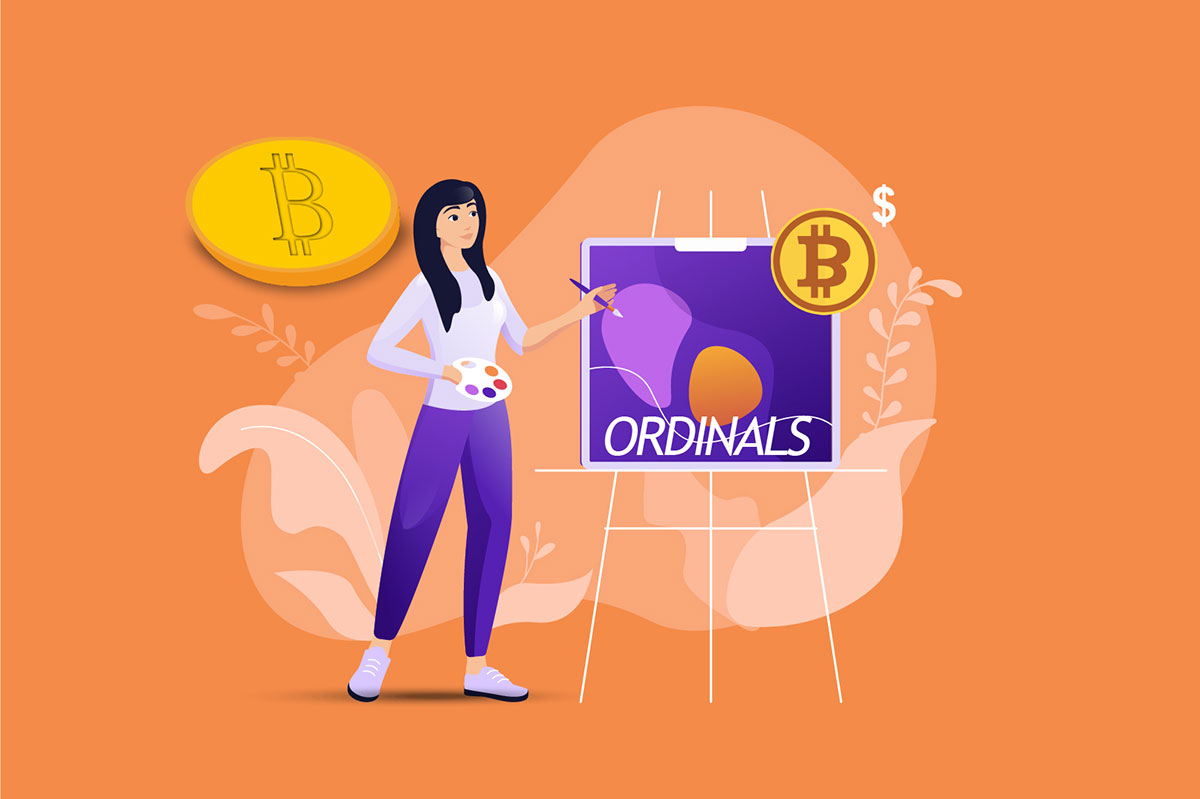Bitcoin Ordinals have been around for months, bringing Bitcoin miners about 1,732 BTC which equals to $46 million using today’s exchange rates. And yet, the concept still brings out confusion even among crypto enthusiasts. If you’re ready to earn on the new blockchain trend but have no idea how – this article is for you.

What Are Ordinals?
What Are Ordinals When It Comes to Bitcoin?
The concept of Bitcoin Ordinals was first introduced in January 2023. It is a method of generating NFTs on the native Bitcoin network by attaching information to individual satoshis (Bitcoin’s smallest units) through a specific process called “inscribing.”
Bitcoin Ordinals Inscriptions Explained
All the fiat currencies have their own derivative units to serve as a medium of exchange (e.g. US dollar consists of 100 cents). The same is true for cryptocurrencies that aim to enable real-life transactions.
Every Bitcoin is made up of 100,000,000 satoshis (sats). This small unit allows investors to make partial payments while trading instead of spending a fortune on buying at least one BTC. It is very helpful considering that the current price of a single Bitcoin token is almost $26.5K at the time of writing and is actually at its low.
However, the rise of NFTs has inspired another use case for satoshis. With the help of the Ordinals protocol, these units can be identified, traced and enriched (inscribed) with unique attributes. This way, they obtain a non-fungible nature and additional value.
This function was not possible until the Taproot upgrade launched in November 2021, creating additional possibility to track each satoshi in the Bitcoin coin supply, from first minting through its entire transactions record.
How Bitcoin Ordinals Work
The Ordinals protocol is a numbering system for satoshis. It gives each satoshi a serial number which enables tracking them across transactions.
As soon as satoshis become unique, you can attach extra metadata (like an image, video or audio file) to them similar to the way it happens with NFTs. This is what we call ‘inscription’.
All satoshis are numbered in the exact order they were mined and transferred. For those of you interested in technical details, the “ordinals” scheme takes into consideration the order of transaction inputs and outputs.
As it happens with all ordinal numbers, the token units are enumerated by successively labelling each element from 0 to infinity. For instance, the first satoshi in the first block has the ordinal number 0, then comes the second under number 1, and so on.
These ordinal numbers become stable identifiers for the data attached to existing sats. The data can be different. Currently, the users have contributed by uploading images, audio, and videos. Other use cases may emerge later as it happened with NFTs now paving the way for individuals and businesses to invest in real estate in the virtual Metaverse.
Moreover, ordinal theorists envision even more unusual use cases such as off-chain coloured-coins, public key infrastructure with key rotation, or a decentralised replacement for the DNS.
How Ordinals on Bitcoin Network Differ from Traditional NFTs
Despite all the similarities, Bitcoin Ordinals differ from the NFTs we’ve known and seen before.
To begin with, NFTs are newly-minted tokens created with the help of smart contracts on various types of blockchains that don’t necessarily host the assets they represent.
Ordinals, on the other hand, are fully located on the main blockchain and do not require a sidechain or separate tokens to get involved in a transaction. Individual satoshis inscribed with metadata are included in blocks directly on the Bitcoin blockchain.
Similar to NFTs, however, ordinal inscriptions range in their unique qualities, being classified from common to epic, legendary, and even mythic. The rarity of an ordinal item depends on its position in the block (e.g. common sat is any sat other than the first one of its block) and the rarity of a certain block itself (i.e. a block that comes right after genesis or halving).
In addition, inscriptions on the Bitcoin network are always immutable, meaning that neither the creator nor the owner of an ordinal can modify it. Standard Ethereum NFTs can be immutable too, but this option requires specific design settings. Those which are not immutable can be changed or deleted by the NFT contract owner.
How to Create Bitcoin Ordinal NFT
To create an inscripted satoshi, you need a compatible digital wallet that allows you to store, send, and receive not only Bitcoin but Ordinal NFTs or the way creators call them ‘digital artefacts’.
- It can be a web wallet or one with a graphical user interface (GUI). The original and recommended wallet is Ord, but installing it requires some technical knowledge of running a full Bitcoin node.
- There are also third-party wallets that are capable of handling Ordinals. Not all the wallets are Ordinals-compatible, so you may first check the tested and most popular variants like Sparrow, Unisat, Oyl, Hiro or Xverse.
Next, and very importantly, you should consider storing your Ordinals and other Bitcoin assets in different wallets unless they support an option to freeze digital artefacts from transactions. The reason is – they may not distinguish between inscripted sats and ordinary ones and can deduct your precious Bitcoin NFTs as a transaction fee.
Therefore, make sure the chosen wallet has “coin control” capability to avoid spending Ordinal satoshis as network fees. If it doesn’t, you’ll also require a digital wallet dedicated to storing Bitcoin.
- It can be both a hot and cold wallet. To discover the difference between those types, read our detailed guideline.
- Some of the most popular software wallets are Metamask and Coinbase, which differ in basic principles of storage organisation, but share similarities in the way they function.
- As for the hardware wallets, Ledger and Trezor are among the most well-established brands in the segment. Yet, other wallet providers such as Blockstream are also continuously updating their products with innovative functions worth checking up on.
- Choose whatever option is suitable for you, set it up and fund the wallet with Bitcoin.
Having all wallets set up, you need to pick up an inscription service.
- No-code tools that enable users to inscribe their ordinal NFTs include Gamma, Ordswap Inscribe or Ordinalsbot.com.
- One more tool is specifically dedicated to textual inscriptions. It is called Inscribe.news.
As you follow the instructions which differ for every service, you’ll be able to create a Bitcoin Ordinal. Typically, you’ll need to upload the desired content and indicate the address you wish your NFT to be sent to. Make sure to use a fresh address for each Ordinal instead of sending multiple artefacts to the same address.
Use your typical wallet to pay the fees incurred. Some services like Ordinalsbot allow you to set a custom fee.
Where to Buy Bitcoin Ordinals
According to the latest statistics, Ordinals have already accumulated about 12.5 million inscriptions recorded on the Bitcoin blockchain.
However, their creation still requires some pretty technical skills, so you may want to stick to trading Bitcoin Ordinals until more user-friendly minting ways appear (which might happen quite soon, judging on the buzz and hype around them).
In this case, you may start looking for a Bitcoin Ordinals supported marketplace. Some of such marketplaces are Magic Eden, Binance NFT Platform, LiteVerse, Ordinals Market, Ordswap, Gamma, OKX NFT Marketplace, ORDX, etc.
Before the popular platforms added this connectivity and new dedicated marketplaces were created, many people traded Ordinals on dedicated Discord servers, with escrows serving as intermediaries. The trading happened in a peer-to-peer over-the-counter (OTC) way and transactions were tracked on Google sheets. Yet, this method was quite old-fashioned, difficult, and often dangerous since trades without intermediaries frequently attract scammers.
With the rapid rise of Ordinals-compatible marketplaces, the adoption of the new NFT-like technology rose so quickly that it even inspired an Ethereum-enabled Ordinals analogue – Ethscriptions.
How to Buy or Sell Bitcoin Ordinals
To perform any kind of transaction with Ordinals, you need a Bitcoin Taproot-compatible wallet e.g. the Ordinals wallet, Unisat, Xverse or Hiro. Once you download one, their use is very simple:
- Create an account, secure your seed phrase, and deposit funds.
- Connect the wallet to a marketplace.
- Set up specific addresses to receive Ordinals.
- Select the Ordinals you wish to purchase and click the “Buy” button.
- For selling, upload the Ordinals you wish to trade to the selected platform.
- Please bear in mind that Bitcoin transactions take time to be confirmed, this can take up to 7 minutes.
In other aspects, buying and selling Bitcoin Ordinals on trusted marketplaces resembles buying ordinary NFTs.
Final Thoughts
Bitcoin Ordinals are yet another innovation that sprang up on the rich blockchain soil. They brought new use cases for the pioneer cryptocurrency, making it more competitive on the global crypto market. At the same time, its wider adoption is partly hindered by the technical expertise required in most inscription methods. Nevertheless, the Ordinals or Bitcoin NFTs as some may call them are very actively traded due to the existence of multiple ordinals-compatible marketplaces that keep growing in number.









